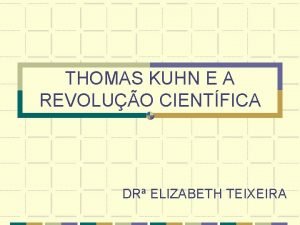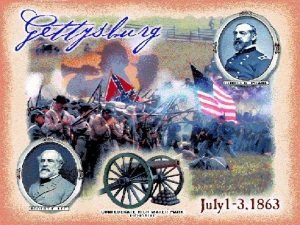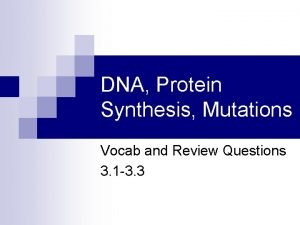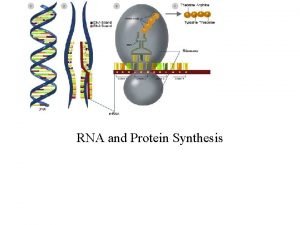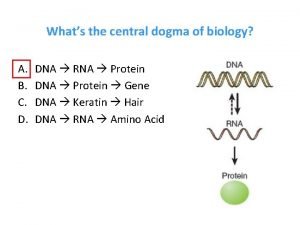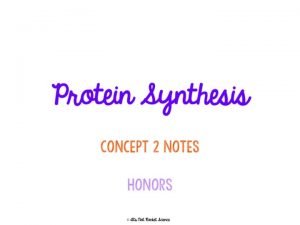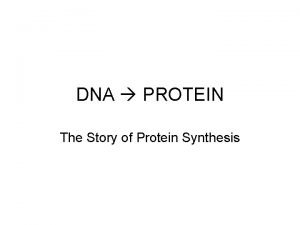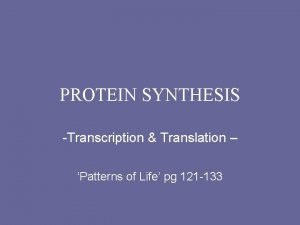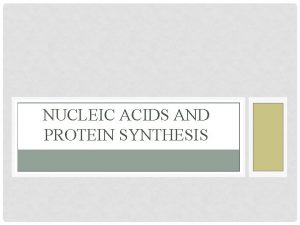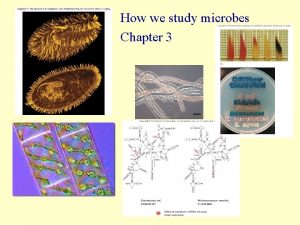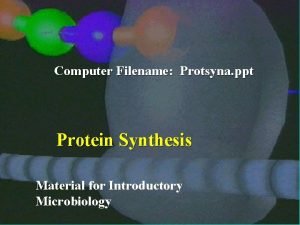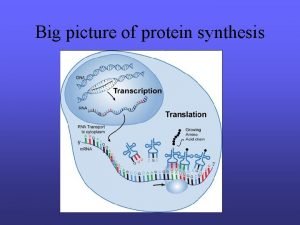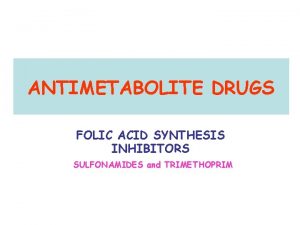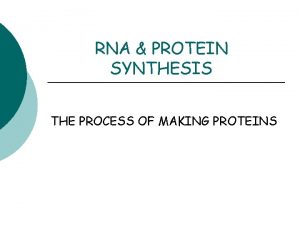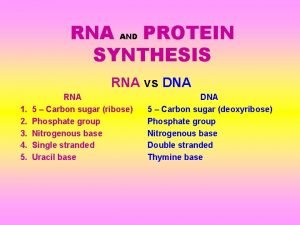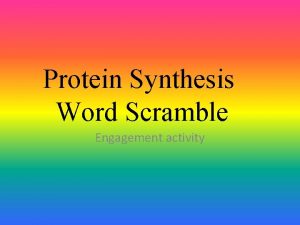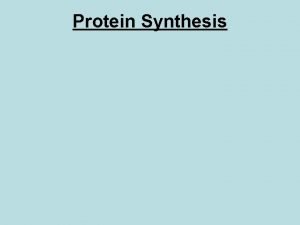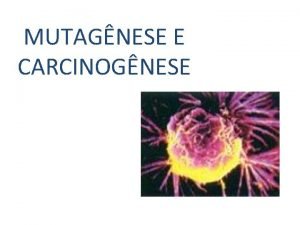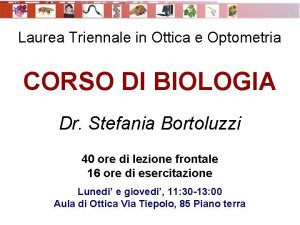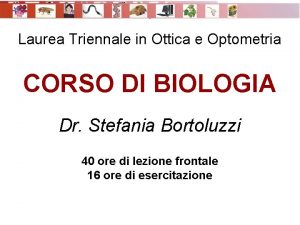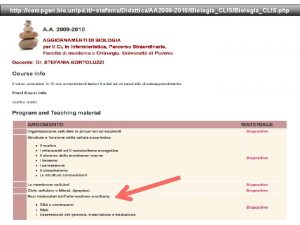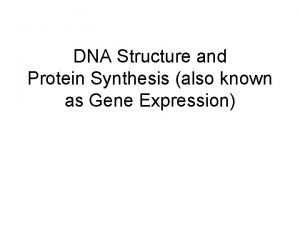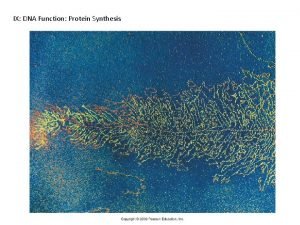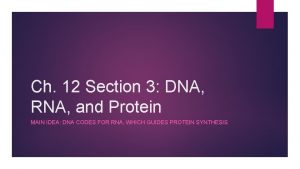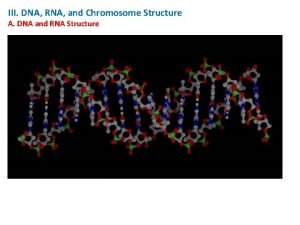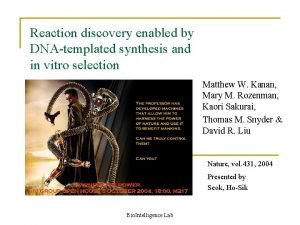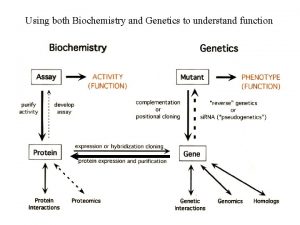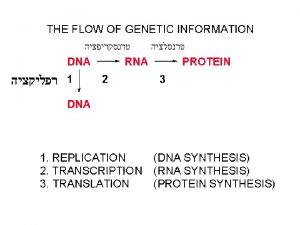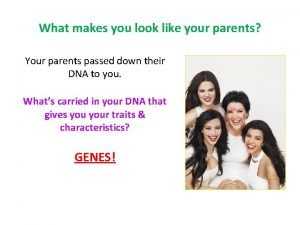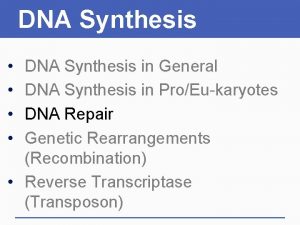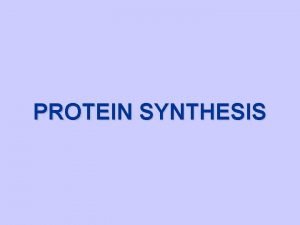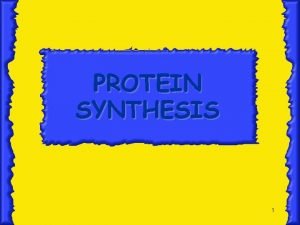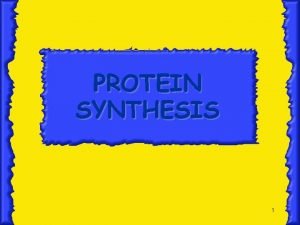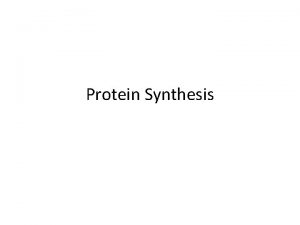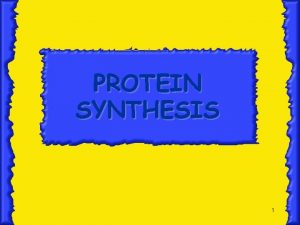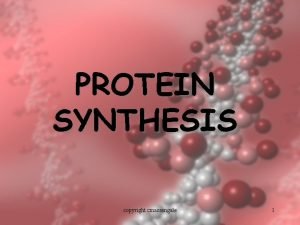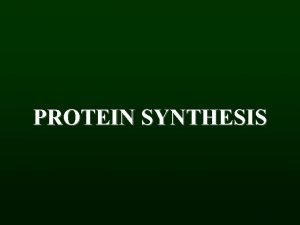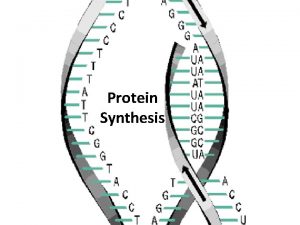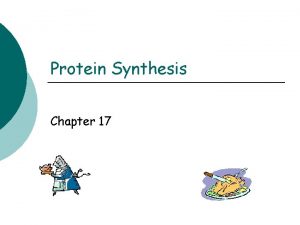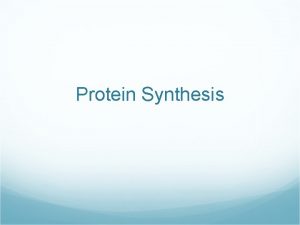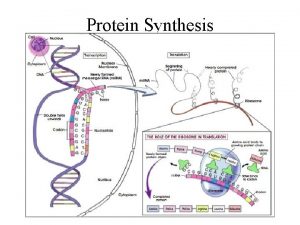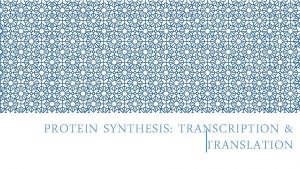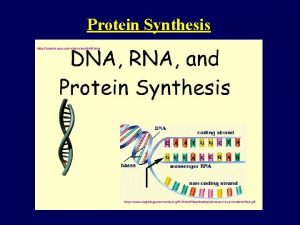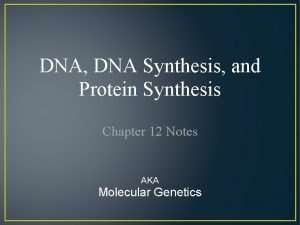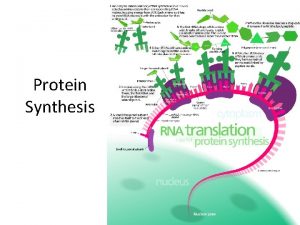DNA and Protein Synthesis Pickett and Kuhn Friday


















































- Slides: 50

DNA and Protein Synthesis Pickett and Kuhn

Friday u. I will be out on Friday and you will have a substitute. u You will start work on the 99 definitions that are on your semester exam. u If you are not working quietly, I will instruct the sub to give you a book work assignment to complete in class instead. Be good. Bring your book.

u For DNA Model each pair, pick up ONE paper from each stack. u Color assignments: – Deoxyribose sugar: white 20 – Phosphorous: green 20 – Adenine: pink 5 – Guanine: orange 5 – Cytosine: yellow 5 – Thymine: blue 5

Corrections u You only need five each of adenine, cytosine, guanine and thymine. u Please label each item as you cut it— this is part of the learning process so that you can remember DNA’s component parts.

Tips Fold your paper in half and trace half as many as you need of each u Use the edge of the paper as one of your straight lines. u “Abut” your tracings so that they share a common straight line—fewer cuts required this way. u Remember that your deoxyribose sugars will run different directions on the two sides of the “ladder” u

DNA basics… u Think about our activity last week where we assembled DNA and record the answers in your notes: – What were three basic parts? – What is the basic shape of the DNA molecule? – What part made up the “rungs” of the ladder? – What parts made up the sides of the ladder?

(In deep voice) DNA: Molecule of heredity! u u Because of the fact that the bases in DNA bind in specific ways (adenine to thymine, guanine to cytosine), DNA is an ideal molecule for heredity because identical DNA strands can be generated using semiconservative replication. The DNA molecule is opened up by the enzyme DNA helicase. Then each strand serves as a template on which new strands are built by another enzyme, DNA polymerase, based on the A-T and G-C pairings. It is called semi-conservative because after replication, each strand is half new strand/half original strand. This process is called DNA synthesis or DNA replication.

DNA transcription (occurs in nucleus) u u HOWEVER, copying DNA is just part of the story. The information that those base pairs carry can be used to produce messenger RNA (m. RNA). The DNA molecule is opened up by the DNA helicase in this process as well, but then RNA polymerase is utilized to copy sections of the DNA into a similar molecule called RNA. This m. RNA takes the information in DNA out to the cytoplasm and uses it to make proteins. RNA has three major differences from DNA: – – – Uses a ribose sugar instead of deoxyribose Uses uracil instead of thymine to pair with adenine Is single-stranded as opposed to double stranded

DNA translation (in the cytoplasm) u The m. RNA exits the nucleus, just a simple chain of nucleotides. The information in this m. RNA is then used to generate proteins using two other types of RNA: – Ribosomal RNA (r. RNA) is the RNA found in ribosomes and is the site where the m. RNA is read and proteins are produced. – Transfer RNA (t. RNA) is the RNA found in specialized RNA/protein molecules that brings in specific amino acids that are indicated by the code in the m. RNA.

DNA translation u During translation, all three types of RNA interact to ultimately generate a string of amino acids called a “polypeptide” which is a precurser of proteins. u Visualizing DNA transcription and translation

BINGO! u Take out your codon tables. u On the bingo cards I give you, make four bingo cards, filling in the boxes with the twenty essential amino acids. BE LOGICAL ABOUT YOUR CHOICES IF YOU WANT A GREATER CHANCE OF WINNING! You may make your cards all the same or all different.

BINGO! Cont. u We will be doing four rounds of bingo. The first two rounds I will read the m. RNA code and you will use your codon table to find the corresponding amino acid which you will then mark off on your card. u The second two rounds I will give you the DNA code which you will then convert to m. RNA to identify the amino acid to mark off on your card.

Telomere Article u Grab a copy of the articles (in front of the computer) and your notebook. Read the articles and record the answers to the questions in your notebook. Use complete sentences. You have about fifteen minutes so use your time wisely. We will be sharing out answers.

Gene regulation u Every cell in the human body has a complete set of DNA. This means your blood cells have the same information as your muscle and nerve cells. How do they know what job to do and what proteins to produce? GENE REGULATION! u This is the process by which cells control what proteins are synthesized.

Gene Regulation in prokaryotes u In prokaryotes, (which have short, circular DNA), gene regulation occurs through the use of an “operon. ” This operon acts as an on/off switch based on environmental clues. We could teach you a lot about this but…. we won’t because we do not have the time.

Gene Regulation in Eukaryotes Everything is much more complex in eukaryotes…the DNA is much, much longer. “Transcription factors” control this process in two ways: u 1. they control whether RNA polymerase binds to the DNA u 2. regulatory proteins control how often and how quickly DNA is transcribed. u One other way that genes are regulated is through the use of RNA interference. u

A little more detail on how DNA is expressed… u First of all, we have lots of extra DNA…DNA that really codes for nothing. The sections of DNA that do not code are called “introns” because they are “interrupting sequences” in the DNA code. The sections of DNA that actually code for proteins are called “exons. ”

Why the flip do eukaryotes have introns in their DNA? u u Introns enable alternative splicing, which enables a single gene to encode multiple proteins that perform different functions under different conditions. For example, a signal the cell receives could cause an exon that is normally included to be skipped, or an intron that is normally spliced out to be left in for translation. This would not be possible, or at least would be much more difficult, without the presence of introns. In recent years, we have discovered that RNA molecules are much more involved in regulating gene expression than previously thought. Often the small regulatory RNAs are derived from spliced introns. So ultimately, introns enable a finer level of regulatory control.

Why the flip don’t prokaryotic cells have introns? u Prokaryotic genes are often organized into operons, and a single polycistronic m. RNA will often encode multiple proteins from multiple adjacent genes. Since the biological processes required to sustain microbial life are much less complicated than those required to sustain eukaryotic life, they can get away with much less regulatory control

When DNA is copied u Remember that one strand of the double helix runs 3’ to 5’ (read 3 prime to 5 prime) and the other runs 5’ to 3’? Well, DNA polymerase can only add bases to the 3’ end, so while it can build DNA continuously on the 5’ to 3’ strand (called the leading strand), it can only build smaller sections on the 3’ to 5’ strand (called the lagging strand). These smaller sections are called “Okazaki fragments” are connected together later in the process of DNA replication. (see p. 334 in book)

THE CENTRAL DOGMA (copy all) DNA --> RNA --> Protein Transcription of DNA to RNA to protein: This dogma forms the backbone of molecular biology and is represented by four major stages. u 1. The DNA replicates its information in a process that involves many enzymes: replication. u 2. The DNA codes for the production of messenger RNA (m. RNA) during transcription.

THE CENTRAL DOGMA cont. (copy all) u u u 3. In eukaryotic cells, the m. RNA is processed (essentially by splicing) and migrates from the nucleus to the cytoplasm. 4. Messenger RNA carries coded information to ribosomes. The ribosomes "read" this information and use it for protein synthesis. This process is called translation. Proteins do not code for the production of protein, RNA or DNA. They are involved in almost all biological activities, structural or enzymatic.


Take out your review guide! u What is the central dogma—see if you can recall it from memory. u Start filling in your review guide. We will go over a few parts together.

u. Teddy Grahams are very scientific? u. And can get uyou extra credit!

Do these teddy grahams look the same?

DNA Profiling (DNA fingerprinting)

Why Use DNA Fingerprinting? DNA fingerprinting is a way of telling individuals of the same species apart n DNA sequences are variable and can therefore be used as identifying characteristics. n DNA fingerprinting has advantages over other sources of evidence (fingerprints, blood type, etc. ): n – Highly accurate. – Can be gathered from trace crime scene evidence.

Who Invented it? u u The process of DNA fingerprinting was invented by Alec Jeffreys at the University of Leicester in 1985. He was knighted in 1994.

Stages of DNA Profiling Step 2: The DNA is cut into fragments using restriction enzymes. u Each restriction enzyme cuts DNA at a specific base sequence.

Stages of DNA Profiling u The sections of DNA that are cut out are called restriction fragments.

RFLP Animation

Individual 1 DNA A B C D E

Individual 2 A B C D

Individual 1 vs. Individual 2 Individual 1 A B Individual 2 A C B D C E D

Stages of DNA Profiling Stage 3: u Fragments are separated on the basis of size using a process called gel electrophoresis. u DNA fragments are injected into wells and an electric current is applied along the gel.


8 Gel electrophoresis DNA extract added well gelatinous sheet solution

Gel electrophoresis thin slab of gel 9 DNA samples placed in wells cut in gel Voltage supply negative electrode positive electrode + DNA fragments Move from negative To positive

12 Appearance of separated fragments on gel These bands will contain the shorter DNA fragments These bands will contain the longer DNA fragments Prof. E. J. Wood E. Wood ©©Prof. starting positions Appearance of bands

Agarose Gel Electrophoresis Different banding patterns from different individuals

Stages of DNA Profiling A radioactive material is added which combines with the DNA fragments to produce a fluorescent image. u A photographic copy of the DNA bands is obtained. u


Uses of DNA Profiling u DNA profiling is used to solve crimes and medical problems

Example u. A violent murder occurred. u The forensics team retrieved a blood sample from the crime scene. u They prepared DNA profiles of the blood sample, the victim and a suspect as follows:

V S S 1 S 2 S 3 DNA profiles V Victim S Sample from crime scene S 1 Suspect 1 S 2 Suspect 2 S 3 Suspect 3 More than 20 fragments from Suspect 1 match those taken from the crime scene 16

Example: A Paternity Test u By comparing the DNA profile of a mother and her child it is possible to identify DNA fragments in the child which are absent from the mother and must therefore have been inherited from the biological father.

20 Genetic fingerprint of … 1 mother 2 child 3 possible father A 4 possible father B There is a match between one of the child’s restriction fragments and one of the mother’s. There is also a match between the child’s other fragment and one from possible father A. 1 2 3 4 Starting position of sample Neither of the child’s restriction fragments match those of possible father B Paternity test

Is this man the father of the child? Mother Child Man

Famous cases In 2002 Elizabeth Hurley used DNA profiling to prove that Steve Bing was the father of her child Damien u
 Dna rna protein synthesis homework #2 dna replication
Dna rna protein synthesis homework #2 dna replication Thomas kuhn elizabeth kuhn
Thomas kuhn elizabeth kuhn Dna protein synthesis study guide answers
Dna protein synthesis study guide answers Lake pickett boat ramp
Lake pickett boat ramp George pickett
George pickett Section 12 3 rna and protein synthesis answers
Section 12 3 rna and protein synthesis answers Missense mutation in sickle cell anemia
Missense mutation in sickle cell anemia Protein synthesis and mutations
Protein synthesis and mutations Protein synthesis and mutations
Protein synthesis and mutations Section 12 3 rna and protein synthesis
Section 12 3 rna and protein synthesis Totipotent cell
Totipotent cell Order of bases in dna
Order of bases in dna Cell analogy restaurant
Cell analogy restaurant Translation or transcription
Translation or transcription Bbc bitesize protein synthesis
Bbc bitesize protein synthesis Protein synthesis cookie analogy
Protein synthesis cookie analogy Whats translation in biology
Whats translation in biology Dna and rna
Dna and rna Protein synthesis
Protein synthesis Protein synthesis
Protein synthesis Protein synthesis story
Protein synthesis story Protein synthesis animation mcgraw hill
Protein synthesis animation mcgraw hill Pap protein synthesis worksheet
Pap protein synthesis worksheet Translation biology
Translation biology Ribonucleic acid
Ribonucleic acid Ribosome
Ribosome Protein synthesis ppt
Protein synthesis ppt Picture of protein synthesis
Picture of protein synthesis Methoteraxate
Methoteraxate Which best summarizes the process of protein synthesis?
Which best summarizes the process of protein synthesis? Concept map of protein synthesis
Concept map of protein synthesis Protein synthesis
Protein synthesis Protein synthesis scramble
Protein synthesis scramble Fictional character μετάφραση
Fictional character μετάφραση Cytosio
Cytosio Teste de ames
Teste de ames Protein synthesis
Protein synthesis Protein synthesis
Protein synthesis Protein synthesis
Protein synthesis Protein synthesis
Protein synthesis Catalytic functions
Catalytic functions Dna vs rna
Dna vs rna Carrier vs channel proteins
Carrier vs channel proteins Protein-protein docking
Protein-protein docking Chapter 12 section 3 dna rna and protein
Chapter 12 section 3 dna rna and protein Bioflix activity dna replication nucleotide pairing
Bioflix activity dna replication nucleotide pairing Chromosome organization
Chromosome organization Dna-templated synthesis
Dna-templated synthesis Dna synthesis at replication fork
Dna synthesis at replication fork Telomerase
Telomerase Dna to protein steps
Dna to protein steps

